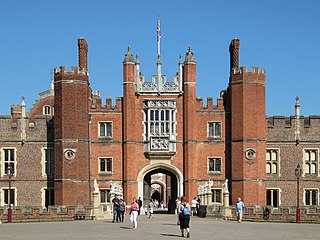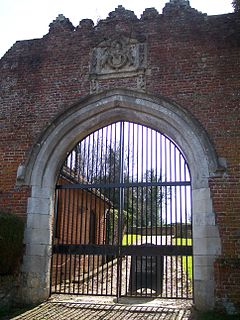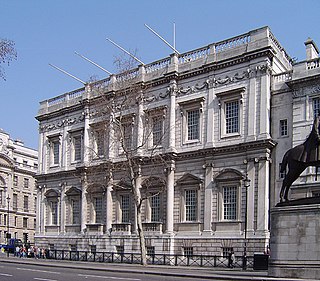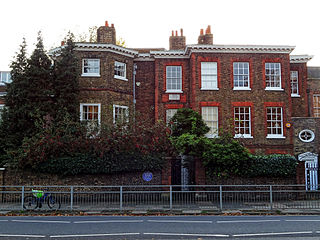Related Research Articles

Charles II was King of England, Scotland, and Ireland. He was King of Scotland from 1649 until his deposition in 1651, and King of England, Scotland and Ireland from the 1660 Restoration of the monarchy until his death in 1685.

Sir Christopher Wren PRS FRS was one of the most highly acclaimed English architects in history, as well as an anatomist, astronomer, geometer, and mathematician-physicist. He was accorded responsibility for rebuilding 52 churches in the City of London after the Great Fire in 1666, including what is regarded as his masterpiece, St Paul's Cathedral, on Ludgate Hill, completed in 1710.

Hampton Court Palace is a Grade I listed royal palace in the London Borough of Richmond upon Thames, 12 miles south west and upstream of central London on the River Thames. Building of the palace began in 1515 for Cardinal Thomas Wolsey, a favourite of King Henry VIII. In 1529, as Wolsey fell from favour, the cardinal gave the palace to the king to check his disgrace. The palace went on to become one of Henry's most favoured residences; soon after acquiring the property, he arranged for it to be enlarged so that it might more easily accommodate his sizeable retinue of courtiers. Along with St James' Palace, it is one of only two surviving palaces out of the many the king owned. The palace is currently in the possession of Queen Elizabeth II and the Crown.
Nicholas Hawksmoor was an English architect. He was a leading figure of the English Baroque style of architecture in the late-seventeenth and early-eighteenth centuries. Hawksmoor worked alongside the principal architects of the time, Christopher Wren and John Vanbrugh, and contributed to the design of some of the most notable buildings of the period, including St Paul's Cathedral, Wren's City of London churches, Blenheim Palace and Castle Howard. Part of his work has been correctly attributed to him only relatively recently, and his influence has reached several poets and authors of the twentieth century.

Marlborough House, a Grade I listed mansion in St James's, City of Westminster, London, is the headquarters of the Commonwealth of Nations and the seat of the Commonwealth Secretariat. It was built for Sarah Churchill, Duchess of Marlborough, the favourite and confidante of Queen Anne. For over a century it served as the London residence of the dukes of Marlborough. It became a royal residence through the 19th century and first half of the 20th. It was leased by Queen Elizabeth II to the Commonwealth beginning in 1965.

The Palace of Whitehall at Westminster, Middlesex, was the main residence of the English monarchs from 1530 until 1698, when most of its structures, except notably Inigo Jones's Banqueting House of 1622, were destroyed by fire. Henry VIII moved the royal residence here after the old royal apartments at the nearby Palace of Westminster were themselves destroyed by fire.

Greenwich Hospital was a permanent home for retired sailors of the Royal Navy, which operated from 1692 to 1869. Its buildings, in Greenwich, London, were later used by the Royal Naval College, Greenwich and the University of Greenwich, and are now known as the Old Royal Naval College. The word "hospital" was used in its original sense of a place providing hospitality for those in need of it, and did not refer to medical care, although the buildings included an infirmary which, after Greenwich Hospital closed, operated as Dreadnought Seaman's Hospital until 1986.

Queen's House is a former royal residence built between 1616 and 1635 in Greenwich, a few miles down-river from the then City of London and now a London Borough. Its architect was Inigo Jones, for whom it was a crucial early commission, for Anne of Denmark, the queen of King James I. Queen's House is one of the most important buildings in British architectural history, being the first consciously classical building to have been constructed in the country. It was Jones's first major commission after returning from his 1613–1615 grand tour of Roman, Renaissance, and Palladian architecture in Italy.

The Palace of Placentia, also known as Greenwich Palace, was an English royal residence that was initially built by Humphrey, Duke of Gloucester, in 1443. It was located at Greenwich on the bank of the River Thames, downstream from London. The original residence was extensively rebuilt around 1500 by Henry VII. In 1660, it was demolished by Charles II to make way for a proposed new palace, which was never constructed. Nearly forty years later, the Greenwich Hospital was built on the site.

Winchester Palace was a 12th-century palace which served as the London townhouse of the Bishops of Winchester. It was located in the parish of Southwark in Surrey, on the south bank of the River Thames on what is now Clink Street in the London Borough of Southwark, near St Saviour's Church which later became Southwark Cathedral. Grade II listed remains of the demolished palace survive on the site today, designated a Scheduled Ancient Monument, under the care of English Heritage.

The Royal Hospital Chelsea is a retirement home and nursing home for some 300 veterans of the British Army. Founded as an almshouse, the ancient sense of the word "hospital", it is a 66-acre (27 ha) site located on Royal Hospital Road in Chelsea. It is an independent charity and relies partly upon donations to cover day-to-day running costs to provide care and accommodation for veterans.

Basing House was a major Tudor palace and castle in the village of Old Basing in the English county of Hampshire. It once rivalled Hampton Court Palace in its size and opulence. Today only parts of the basement or lower ground floor, plus the foundations and earthworks, remain. The ruins are a Grade II listed building and a scheduled monument.

Richmond Palace was a royal residence on the River Thames in England which stood in the sixteenth and seventeenth centuries. Situated in what was then rural Surrey, it lay upstream and on the opposite bank from the Palace of Westminster, which was located nine miles (14 km) to the north-east. It was erected about 1501 by Henry VII of England, formerly known as the Earl of Richmond, in honour of which the manor of Sheen had recently been renamed "Richmond". Richmond Palace therefore replaced Shene Palace, the latter palace being itself built on the site of an earlier manor house which had been appropriated by Edward I in 1299 and which was subsequently used by his next three direct descendants before it fell into disrepair.

Winchester Castle is a medieval building in Winchester, Hampshire, England. It was founded in 1067. Only the Great Hall still stands; it houses a museum of the history of Winchester.

Tom Tower is a bell tower in Oxford, England, named after its bell, Great Tom. It is over Tom Gate, on St Aldates, the main entrance of Christ Church, Oxford, which leads into Tom Quad. This square tower with an octagonal lantern and facetted ogee dome was designed by Christopher Wren and built 1681–82. The strength of Oxford architectural tradition and Christ Church's connection to its founder, Henry VIII, motivated the decision to complete the gatehouse structure, left unfinished by Cardinal Wolsey at the date of his fall from power in 1529, and which had remained roofless since. Wren made a case for working in a Late Gothic style—that it "ought to be Gothick to agree with the Founders worke"—a style that had not been seen in a prominent building for a hundred and fifty years, making Tom Tower a lonely precursor of the Gothic Revival that got underway in the mid-18th century. Wren never came to supervise the structure as it was being erected by the stonemason he had recommended, Christopher Kempster of Burford.

St Alban's was a church in Wood Street, City of London. It was dedicated to Saint Alban. Of medieval origin, it was rebuilt in 1634, destroyed in the Great Fire of London in 1666, and rebuilt, this time to a Gothic design by Sir Christopher Wren. It was severely damaged by bombing during the Second World War and the ruins cleared, leaving only the tower.

Kneller Hall is a Grade II listed mansion in Whitton, in the London Borough of Richmond upon Thames. It houses the Royal Military School of Music, training musicians for the British Army, which acquired the building in the mid-19th century. It is also home to the school's Museum of Army Music. The Army is scheduled to vacate the site in 2020.

The Banqueting House, Whitehall, is the grandest and best known survivor of the architectural genre of banqueting house, which were constructed for elaborate entertaining. It is the only remaining component of the Palace of Whitehall, the residence of English monarchs from 1530 to 1698. The building is important in the history of English architecture as the first structure to be completed in the neo-classical style, which was to transform English architecture.

Hungerford Market was a produce market in London, at Charing Cross on the Strand. It existed in two different buildings on the same site, the first built in 1682, the second in 1832. The market was first built on the site of Hungerford House, next to Durham Yard, the town house of the Hungerford family. The house had burned down in 1669 as is recorded in the Diary of Samuel Pepys. It was replaced by a new Italianate market building by Charles Fowler, which opened in 1833. The new market was unsuccessful. It was damaged when the adjoining Hungerford Hall burned down in 1854, and was sold to the South Eastern Railway in 1862. Charing Cross railway station was built on the site and opened in 1864.

The Old Court House is a Grade II* listed house located off Hampton Court Green in the London Borough of Richmond upon Thames; its origins date back to 1536. The architect Sir Christopher Wren, who lived there from 1708 to 1723, was given a 50-year lease on the property by Queen Anne in lieu of overdue payments for his work on St Paul's Cathedral. The lease passed from Wren's son to his grandson. It was purchased from the Crown Estate in 1984.

